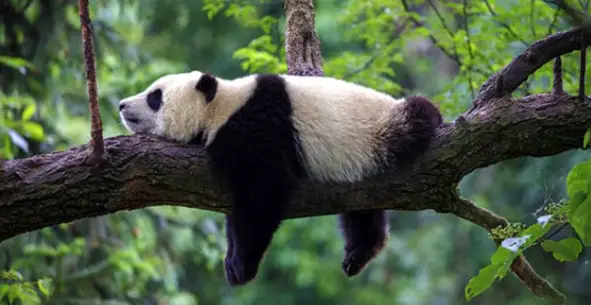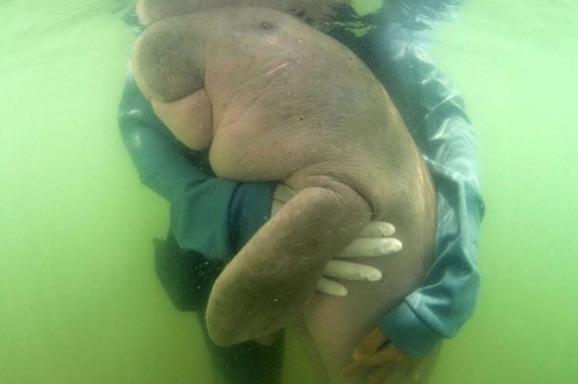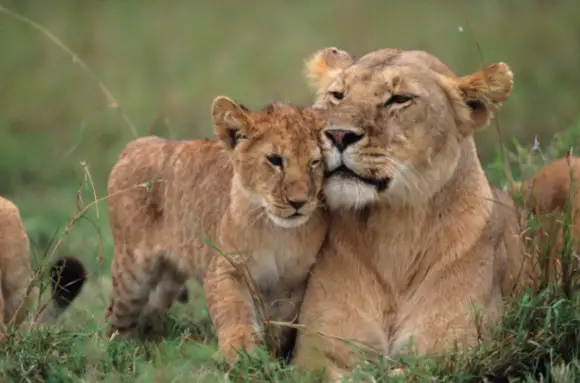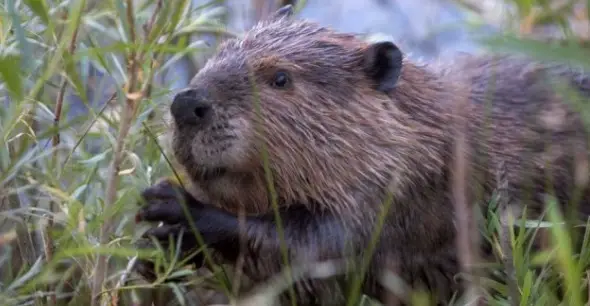10.Panda Boot Camp

Some captive panda breeding programs ended in distress, such as when Xiang Xiang, the captive-bred panda, was killed just one year after being released into the wild. That’s where the idea of panda training ground comes in. Tao Tao was a giant panda raised in the Wolong Nature Reserve with the aim of preparing it to live in the wild. In addition to training his mother in basic skills like climbing, the scientists put Tao Tao through drills to prepare him for hazards like storms, landslides, and predators. Most importantly, they only interacted with him wearing panda costumes and scents so he wouldn’t get used to humans. Tao Tao was released in 2012 and recaptured for a medical check-up in 2017, where it was reported that he was thriving in the wild. The Wolong Panda Survival School raises several panda cubs each year, putting them through strict drills to make sure they can take care of themselves in the wild.
9.Fish-Zapping Vaccuum Robots
From the creators of Roomba comes The Guardian, a friendly marine robot on a mission to kill as many lionfish as possible. The lionfish is a poisonous species that has become a major threat in areas like the Bahamas, where it consumes many more species than any local predator. No predator is interested in lionfish because of its venom, but humans can eat it when properly prepared. The problem is that they are difficult to catch with traditional fishing methods. That’s where the Guardian comes in. The current version of the Guardian can swim up to 500 feet below the surface, where it stuns lionfish and sucks them into a holding tube. so they can reappear. It still requires remote control when launched into the ocean to make sure it doesn’t attack similar species by mistake, but future iterations will likely be able to spot lionfish with Terminator-like precision.
8.Dugong Drone Surveillance

Dugongs are an eastern relative of the manatee whose habitat is important to the coastal ecosystem of the Indian and western Pacific oceans. Since they are very shy creatures, it has been a real mess for scientists to monitor this unique and threatened species using traditional methods. Until recently, the best option was an aerial reconnaissance with a seaplane, but such flights can be dangerous and expensive, especially when you run out of gas hundreds of miles from the nearest inhabited island. remote tracking method that is much more environmentally friendly and accurate than using airplanes. The drones are launched from small boats and collect thousands of images in one flight, which are analyzed by a dugong detection algorithm that is correct 70% of the time. This allows researchers to produce population density maps for this vulnerable species in a few days, making it an incredibly useful and time-saving process. Probably a much better use of drone technology than anything your weird neighbor is doing with them.
7.Undercover Crane

If you want to hang with cranes, you have to show off the piece. That’s the idea behind breeding programs that breed whooping cranes with human surrogates in white robes and crane-shaped hand puppets. Human-reared whooping cranes often imprint themselves on them, recognizing them as keepers. This can lead to a serious identity crisis when the crane reaches mating age and sees humans as potential mates. The obvious solution is to trick the cranes into thinking that we are cranes too. Cranes are the tallest bird in North America, so it’s easy for them to see us as equal in terms of size. All you need to complete the costume is a head-to-toe white cover with a crane head puppet at the end of one arm. Human noises are limited around the cranes and calls are issued for the chicks to get used to the sound of their own species. Conservation efforts like these have helped rescue the whooping crane from the brink of extinction. In the 1940s, only 16 cranes remained; that number is now over 800, most of them in the wild.
6.Robot Scarecrow Fish
Not all fish control projects require hijacking invasive species in a vacuum robot. Sometimes all you need to do is scare them a little. This was the idea behind a silicone robot built by New York University researchers to look and act like a large-mouth bass. Their target is the mosquito fish, a small species that was introduced to many freshwater environments to control mosquito populations but has now become an ecological threat. Initial testing of this scarecrow showed that it was capable of inducing stress in mosquito populations and even cause them to lose weight. . Stress and weight loss reduce their chances of reproduction, which would help control the population. The goal is to reduce mosquito fish populations without having to kill them, both out of human concerns and because the species is so widespread that it would be difficult to kill them in large numbers without affecting the overall ecosystem. The robot bass is still in the prototype stages, but future iterations could be launched into the wild to swim and scare every mosquito fish they see.
5.Transcontinental Muskox Train
This is a throwback to the early days of conserving American wildlife. The musk ox was prevalent in parts of Alaska until the late 1800s, when a combination of overhunting and weather conditions wiped out Alaska’s last herds. Something about that did not sit well with American lawmakers, because in the 1930s the United States Congress allocated funds for the reintroduction of musk oxen in Alaska. Thanks to this effort, today the state’s musk ox population exceeds 5,000, here’s how they did it: First, a group of Norwegian sailors captured 34 Greenland musk oxen and brought them back to Norway, where they boarded a steamboat bound for New York. Town. There they spent a month in quarantine, safe but unable to enjoy the glitz and glamor of the Big Apple. The pack then boarded a train bound for Seattle and another steamboat from there to Seward, Alaska. They took another train to Fairbanks, Alaska, where they received a five-year break before boarding another steamboat that took them to Nunivak Island in the Bering Sea (and nearly sank en route). Remember that musk oxen are covered in two layers of shaggy wool designed to withstand arctic winters, and now imagine how uncomfortable that 13,000-kilometer journey must have been. Still, most of the original herd survived and Nunivak’s population is now around 600. She also sowed several other herds on mainland Alaska that are thriving to this day.
4.Electroejaculation

Artificial insemination is common in agriculture and conservation, but some species don’t like … let’s say, manual harvesting. Horses and some friendlier bulls can be persuaded to forgo old-fashioned specimens in a pinch, but what about when you need seeds of something a little more aggressive, like a lion or a tiger? One of the solutions is electroejaculation, which is used more in cattle whose owners do not feel like getting too close. Methods vary, but the basics involve inserting a rectal probe that ranges from zero to maximum voltage, stimulating muscle contractions to induce ejaculation. Prototypes developed in house cats with plastic tubes and copper wires have been reformatted for larger animals such as Amur leopards and Siberian tigers. A recent Singapore Zoo success story produced a lion cub named Simba from the electroejaculation of a geriatric lion whose name you should be able to guess. Simba was Mufasa’s first cub, aged 20, and unfortunately his last as well, as he did not survive the shocking procedure. It’s still a better way to do it than being trampled by wildebeest.
3.Bird Ejaculation Helmet
Sirocco the kakapo is a bird from New Zealand who is very fond of people. The flightless night parrot comes from a species that is nearly extinct but is making a comeback due to breeding efforts. Unfortunately for Sirocco, he grew up surrounded by humans and imprinted on his caretakers, causing him to have little interest in mating with his own kind. However, she has tried to mate with humans, most notably in a 2009 viral video where she mounts zoologist Mark Cawardine and bravely tries to make babies out of the scientist’s skull. His affection for human heads led scientists to invent Sirocco as an “ejaculation helmet.” a rubber cap covered with small dimples to collect semen. The problem is that kākāpō are long-winded lovers, often taking almost an hour to finish. No one had the energy to let Sirocco spoon their skulls for so long, which is why the bird remained celibate. Despite the failure of the ejaculation helmet itself, Sirocco’s insane history has drawn worldwide attention to the plight of his species, which is why we count it as a victory for conservation anyway. The celebrated bird is now in his early twenties and lives alone on an island, occasionally accepting visits from the bosses of past lovers. The helmet is on display in the National Museum in Wellington.
2.Poison Toad Sausage

Cane toads are one of the most notorious invasive species in the world. Videos of motorists running over poisonous amphibians have drawn attention to how despised this species is in Australia. One of the biggest concerns is its effect on animals such as the quoll, a small marsupial that feeds on the cane toad but can die from the poison in its glands. Cane toads are apparently too tasty to pass up, so scientists have developed a way to strip quolls of the taste of toad meat. Live toads are first frozen to death, skinned, and ground into hot dogs, a process that is notoriously stinky. The sausage maker then adds a chemical called tibenzol that causes nausea in animals. Finally, contaminated toad sausages are dropped into quoll country by helicopter. Although initial results after the first drop in 2018 were questionable, the sausage strategy appears to be driving quolls away from cane toads.
1.Beaver Skydiving

After World War II, people began moving to the Payette Lake, Idaho area, where local beavers had been busy for centuries without a Mini-Mart in sight. After a while, beavers began to fight human settlements and caused real damage to irrigation systems and orchards. It’s no wonder people weren’t interested in moving, so they had to find a way to keep beavers away. Idaho’s mountainous terrain made relocation by horse and truck costly and dangerous for beavers, who cannot withstand long periods of heat out of the water. The solution came in the form of military aircraft and parachutes to spare. Through a series of tests, wildlife managers developed a box that was sturdy enough to hold a beaver and would open smoothly when it touched the ground. The first tests were done on an old beaver named Geronimo, who was thrown from a plane into a beaver box with a parachute over and over again until scientists were sure he was safe. However, don’t feel bad for old Geronimo. He obtained priority registration on the first flight to the new territory, along with a harem of three women to keep him company. Seventy-six beavers in all were transplanted safely into the wilds of Idaho, with only one victim whose box was opened early and fell over.





